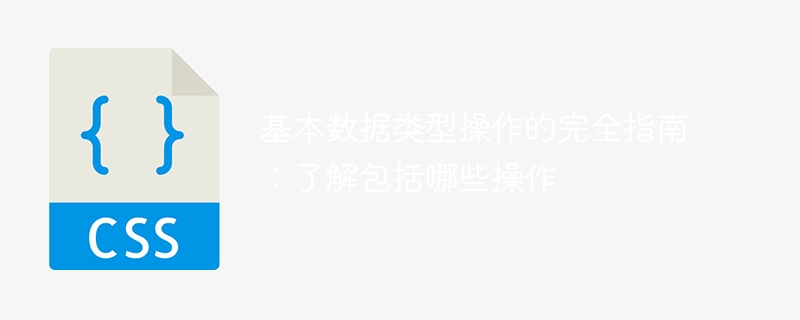Home >Web Front-end >CSS Tutorial >A Complete Guide to Basic Data Type Operations: Learn Which Operations Are Included
A Complete Guide to Basic Data Type Operations: Learn Which Operations Are Included
- PHPzOriginal
- 2024-02-20 19:36:031122browse

A complete guide to operations on basic data types: To understand which operations are included, specific code examples are required
Overview:
In programming, working with basic data types is a a basic and essential task. Understanding the operation and use of basic data types can help developers better solve problems and optimize code.
This article will introduce common basic data type operations, including integer, floating point, character and Boolean operations, as well as related code examples.
1. Integer operations
-
Declare and initialize integer variables:
int num = 10;
-
Integer operations:
int sum = 5 + 3; // 加法 int difference = 5 - 3; // 减法 int product = 5 * 3; // 乘法 int quotient = 5 / 3; // 除法 int remainder = 5 % 3; // 取模
-
Increase and decrement:
int i = 1; i++; // 自增,i的值变为2 int j = 2; j--; // 自减,j的值变为1
-
Comparison operation:
int a = 5; int b = 3; boolean isEqual = (a == b); // 判断a是否等于b,返回false boolean isGreater = (a > b); // 判断a是否大于b,返回true boolean isLess = (a < b); // 判断a是否小于b,返回false
2. Floating point type Operation
-
Declare and initialize floating-point variables:
float num = 3.14f; double pi = 3.14159;
-
Floating-point operations:
double sum = 1.2 + 2.3; // 加法 double difference = 3.5 - 1.2; // 减法 double product = 2.5 * 4.5; // 乘法 double quotient = 10.0 / 3.0; // 除法
-
Comparison operation:
double a = 3.14; double b = 3.14159; boolean isEqual = (a == b); // 判断a是否等于b,返回false boolean isGreater = (a > b); // 判断a是否大于b,返回false boolean isLess = (a < b); // 判断a是否小于b,返回true
3. Character operation
-
Declare and initialize character variables:
char c = 'A';
-
Character type conversion:
int num = (int) c; // 将字符转换为对应的ASCII码值
-
String connection:
char c1 = 'A'; char c2 = 'B'; String str = Character.toString(c1) + Character.toString(c2); // 字符串连接,结果为"AB"
4. Boolean operations
-
Declare and initialize Boolean variables:
boolean isTrue = true;
-
Logical operations:
boolean result = true && false; // 逻辑与运算,结果为false boolean result = true || false; // 逻辑或运算,结果为true boolean result = !true; // 逻辑非运算,结果为false
Conclusion:
This article introduces Common operations on basic data types, including operations on integers, floating point types, character types, and Boolean types. By understanding and mastering the details and usage of these operations, developers can better solve problems and write efficient code using basic data types.
Please note that in actual development, issues such as the range, precision, and overflow of data types must also be considered. In addition, the code examples are for illustrative purposes only and are not complete program codes. Actual use requires appropriate modifications and extensions based on specific needs.
The above is the detailed content of A Complete Guide to Basic Data Type Operations: Learn Which Operations Are Included. For more information, please follow other related articles on the PHP Chinese website!

